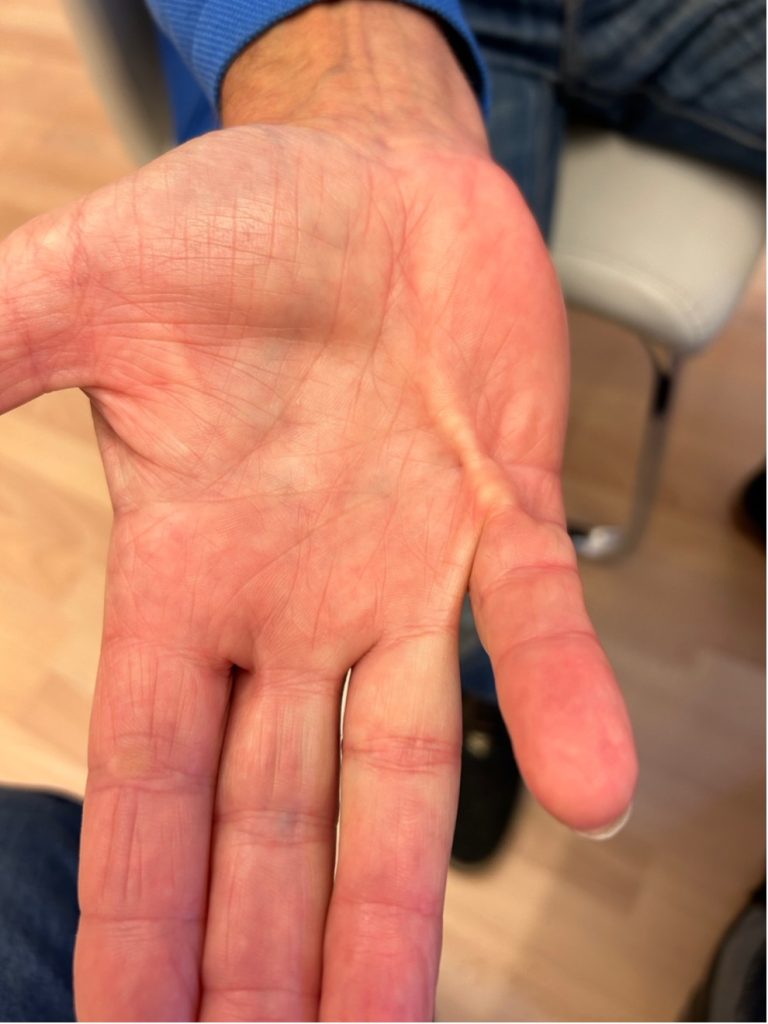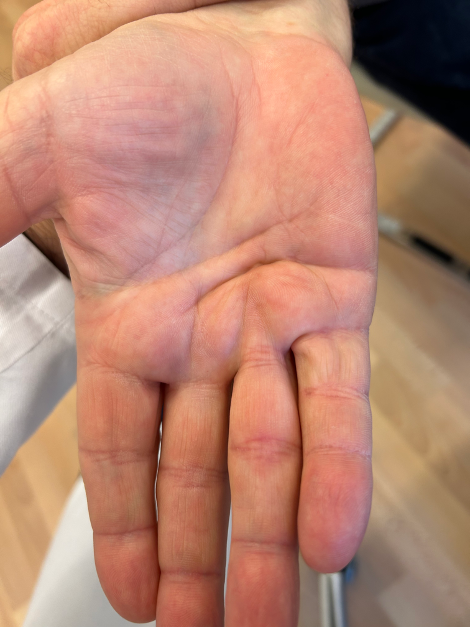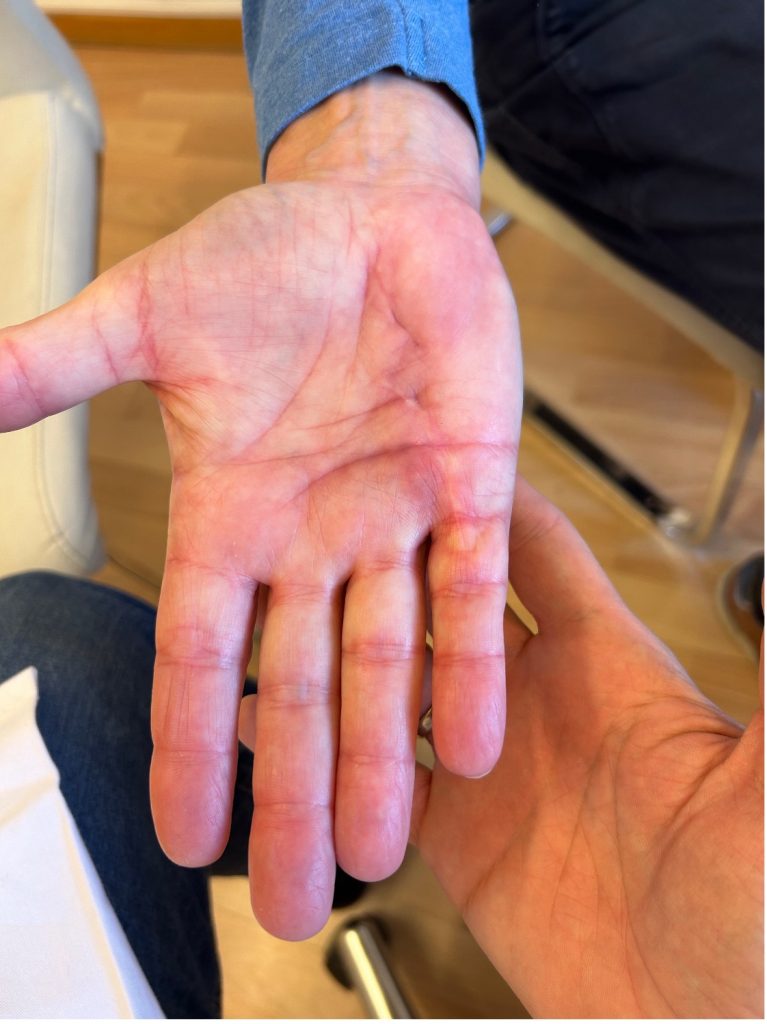Dupuytren's contracture
Causes, symptoms and treatment
What initially appears to be a harmless change in the hand – a slight hardening, a minimal curvature – can gradually develop into a massive impact on quality of life. Suddenly shaking hands becomes difficult, gripping becomes a challenge and simple everyday tasks feel alien.
Dupuytren’s contracture is a condition that often begins unnoticed – and then never lets up. But what exactly is behind it? What are the first warning signs? And what treatment options are available before everyday life becomes a burden?

What is Dupuytren's contracture?
Dupuytren’s contracture, also known as Dupuytren’s contracture or Dupuytren’s disease, is a hand deformity caused by a disease of the fibrous tissue in the palm of the hand. The fasciae in the hand shrink and contract. This results in the formation of knots and cords, which causes the fingers to be in a continuous flexed position. At an advanced stage, it can even lead to a claw position. Men are more frequently affected by this disease than women, and in most cases it occurs from the age of 40. For the patient, this can mean an increasing reduction in quality of life, especially if everyday movements are only possible to a limited extent.
What are the causes of Dupuytren's contracture?
The current state of medical knowledge is that the cause of Dupuytren’s contracture is unknown. Scientists are not sure what triggers the hand deformity. Hereditary components as well as injuries are currently being discussed as causes. One thing is clear: people who suffer from diabetes or have an increased consumption of alcohol and cigarettes are more frequently affected by the disease, as are those in northern Europe.
Symptoms of Dupuytren's contracture
The symptoms of Dupuytren’s contracture usually begin harmlessly and gradually. In most cases, the little finger and the ring finger are affected, in rare cases other fingers. In 80% of cases, the symptoms occur on both sides of the hand.
Symptoms of Dupuytren's contracture
The symptoms of Dupuytren’s contracture usually begin harmlessly and gradually. In most cases, the little finger and the ring finger are affected, in rare cases other fingers. In 80% of cases, the symptoms occur on both sides of the hand.
- Nodular indurations: At the beginning of the disease, slight indurations can be palpated on the flexor of the eye, usually painless.
- Fingers can no longer be stretched out: As the condition progresses, the growths on the flexor tendon spread and mean that fingers can no longer be fully extended and therefore remain in a crooked position.
- Sensory and circulatory disorders: The growths can press on the surrounding nerves and blood vessels and thus cause these symptoms, albeit very rarely.
These changes increasingly lead to functional limitations that cause noticeable problems in everyday life – e.g. when gripping, writing or shaking hands.

Diagnostics
Due to the typical changes – such as palpable lumps and strands – the diagnosis is usually made quickly. Nevertheless, it is important to seek medical advice at the first signs, as similar symptoms can also occur with other conditions such as rapid fingers or benign or malignant tumors.
Early clarification can not only have a positive influence on the course of the disease, but can also help to reduce uncertainty and anxiety among those affected
Treatment - therapy and operation
Conservative treatment
Conservative therapies are usually not promising, as this disease is progressive and cannot be significantly influenced by the usual conservative methods. In rare, mild cases, initial splint treatment may be considered. Alternatively, an injection of collagenase into the scar cord can be tried in selected cases.
Surgical treatment
If the hand can no longer be placed flat on the table and one or more fingers are so bent that function is severely impaired, surgery is necessary.
The surgeon removes the affected cords and fascia in the palm of the hand. As they are closely connected to nerves, blood vessels and tendons, the procedure is somewhat complex. Nevertheless, the relapse rate is lower than with conservative methods. A recovery phase is necessary after the procedure. The hand is immobilized, followed by intensive physiotherapy. Wearing a splint for several months is also recommended in order to control renewed movements and stabilize function. Treatment with a needle (needle fasciotomy) is not recommended by Dr. Farr due to the risk of vascular nerve injury and failure to correct the cause.

Living with Dupuytren's contracture
A diagnosis of Dupuytren’s contracture is no reason for resignation – but it is a reason to take a more conscious approach to your everyday life. Even if the condition cannot be completely cured, there are many ways to alleviate its effects, promote mobility and actively master everyday life.
Occupational therapy and targeted exercises
Regular occupational therapy measures can help to maintain or even slightly improve the mobility of the hand. Especially after an operation, follow-up treatment is crucial to support the return to a normal everyday life.
- Stretching exercises for the palm of the hand
- Mobilization of the scar and the underlying tissue
- Coordination exercises
- Load balancing for everyday tasks
Your specialist for hand surgery in Vienna - Dr. Sebastian Farr
Priv.-Doz. Dr. Sebastian Farr is a specialist in orthopaedics and hand surgery with many years of experience as a senior physician at the Orthopaedic Hospital Speising. At his surgery in the 1st district, he offers comprehensive advice and individual treatment options for diseases and injuries of the hand and upper extremities. From diagnosis to treatment and aftercare, Dr. Farr will accompany you personally and attaches great importance to precise diagnostics and targeted treatment. The aim is to restore hand function in the best possible way and to alleviate pain in the long term.
Arrange a consultation today by e-mail, online or by telephone and let Priv.-Doz. Dr. Sebastian Farr personally about your treatment options – for more comfort, quality of life and an active life!

FAQ - frequently asked questions about Dupuytren's contracture
What is Dupuytren's contracture in simple terms?
It is a disease of the hand in which the connective tissue under the skin contracts and forces the fingers into a bent position.
Which fingers are most frequently affected?
Mostly the ring finger and the little finger – often on both sides.
Is the disease painful?
Usually not in the early stages. Pain can occur if nerves or blood vessels are affected.
What are the risk factors for the disease?
What are the risk factors for the disease?
Genetic predisposition, diabetes, alcohol and nicotine consumption are among the main risk factors.
Is there a cure?
There is no complete cure, but there are mainly surgical therapies available that can significantly improve mobility.
When is an operation necessary?
If hand function is severely restricted, e.g. if the hand can no longer be placed flat on the table.
Can the disease return after treatment?
Yes, recurrence is possible – but less often with surgical treatment than with conservative methods.